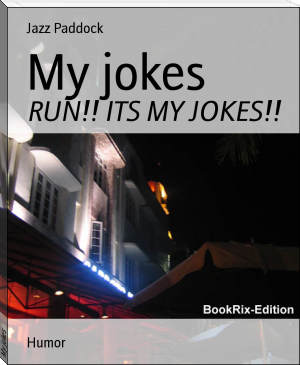A Book of Burlesques, H. L. Mencken [best e book reader .txt] 📗

- Author: H. L. Mencken
Book online «A Book of Burlesques, H. L. Mencken [best e book reader .txt] 📗». Author H. L. Mencken
Leaps to heaven from the abyss:
—The mountains shake themselves and
Their intestines....
IV
Are united, a curse!
On the mountains rages now Zarathustra’s wrath,
Like a thunder cloud rolls it on its way.
V
To bed with you, ye tenderlings!
[30]Now thunder rolls over the great arches,
Now tremble the bastions and battlements,
Now flashes palpitate and sulphur-yellow truths—
Zarathustra swears ...!
The composition is scored for three flutes, one piccolo, one bass piccolo, seven oboes, one English horn, three clarinets in D flat, one clarinet in G flat, one corno de bassetto, three bassoons, one contra-bassoon, eleven horns, three trumpets, eight cornets in B, four trombones, two alto trombones, one viol da gamba, one mandolin, two guitars, one banjo, two tubas, glockenspiel, bell, triangle, fife, bass-drum, cymbals, timpani, celesta, four harps, piano, harmonium, pianola, phonograph, and the usual strings.
At the opening a long B flat is sounded by the cornets, clarinets and bassoons in unison, with soft strokes upon a kettle-drum tuned to G sharp. After eighteen measures of this, singhiozzando, the strings enter pizzicato with a figure based upon one of the scales of the ancient Persians—B flat, C flat, D, E sharp, G and A flat—which starts high among the first violins, and then proceeds downward, through the second violins, violas and cellos, until it is lost in solemn and indistinct mutterings in the double-basses. Then, the atmosphere of doom [31]having been established, and the conductor having found his place in the score, there is heard the motive of brooding, or as the German commentators call it, the Quälerei Motiv:

The opening chord of the eleventh is sounded by six horns, and the chords of the ninth, which follow, are given to the woodwind. The rapid figure in the second measure is for solo violin, heard softly against the sustained interval of the diminished ninth, but the final G natural is snapped out by the whole orchestra [32]sforzando. There follows a rapid and daring development of the theme, with the flutes and violoncellos leading, first harmonized with chords of the eleventh, then with chords of the thirteenth, and finally with chords of the fifteenth. Meanwhile, the tonality has moved into D minor, then into A flat major, and then into G sharp minor, and the little arpeggio for the solo violin has been augmented to seven, to eleven, and in the end to twenty-three notes. Here the influence of Claude Debussy shows itself; the chords of the ninth proceed by the same chromatic semitones that one finds in the Chansons de Bilitis. But Kraus goes much further than Debussy, for the tones of his chords are constantly altered in a strange and extremely beautiful manner, and, as has been noted, he adds the eleventh, thirteenth and fifteenth. At the end of this incomparable passage there is a sudden drop to C major, followed by the first statement of the Missgeschick Motiv, or motive of disaster (misfortune, evil destiny, untoward fate):

[33]
This graceful and ingratiating theme will give no concern to the student of Ravel and Schoenberg. It is, in fact, a quite elemental succession of intervals of the second, all produced by adding the ninth to the common chord—thus: C, G, C, D, E—with certain enharmonic changes. Its simplicity gives it, at a first hearing, a placid, pastoral aspect, somewhat disconcerting to the literalist, but the discerning will not fail to note the mutterings beneath the surface. It is first sounded by two violas and the viol da gamba, and then drops without change to the bass, where it is repeated fortissimo by two bassoons and the contra-bassoon. The tempo then quickens and the two themes so far heard are worked up into a brief but tempestuous fugue. A brief extract will suffice to show its enormously complex nature:

[34]A pedal point on B flat is heard at the end of this fugue, sounded fortissimo by all the brass in unison, and then follows a grand pause, twelve and a half measures in length. Then, in the strings, is heard the motive of warning:

[35]Out of this motive comes the harmonic material for much of what remains of the composition. At each repetition of the theme, the chord in the fourth measure is augmented by the addition of another interval, until in the end it includes every tone of the chromatic scale save C sharp. This omission is significant of Kraus’ artistry. If C sharp were included the tonality would at once become vague, but without it the dependence of the whole gorgeous edifice upon C major is kept plain. At the end, indeed, the tonic chord of C major is clearly sounded by the wood-wind, against curious triplets, made up of F sharp, A flat and B flat in various combinations, in the strings; and from it a sudden modulation is made to C minor, and then to A flat major. This opens the way for the entrance of the motive of lamentation, or, as the German commentators call it, the Schreierei Motiv:

This simple and lovely theme is first sounded, not by any of the usual instruments of the grand orchestra, but by a phonograph in B flat, with the accompaniment of a solitary trombone. [36]When the composition was first played at the Gewandhaus in Leipzig the innovation caused a sensation, and there were loud cries of sacrilege and even proposals of police action. One indignant classicist, in token of his ire, hung a wreath of Knackwürste around the neck of the bust of Johann Sebastian Bach in the Thomaskirche, and appended to it a card bearing the legend, Schweinehund! But the exquisite beauty of the effect soon won acceptance for the means employed to attain it, and the phonograph has so far made its way with German composers that Prof. Ludwig Grossetrommel, of Göttingen, has even proposed its employment in opera in place of singers.
This motive of lamentation is worked out on a grand scale, and in intimate association with the motives of brooding and of warning. Kraus is not content with the ordinary materials of composition. His creative force is always impelling him to break through the fetters of the diatonic scale, and to find utterance for his ideas in archaic and extremely exotic tonalities. The pentatonic scale is a favorite with him; he employs it as boldly as Wagner did in Das Rheingold. But it is not enough, for he proceeds from it into the Dorian mode of the ancient Greeks, and then into the Phrygian, [37]and then into two of the plagal modes. Moreover, he constantly combines both unrelated scales and antagonistic motives, and invests the combinations in astounding orchestral colors, so that the hearer, unaccustomed to such bold experimentations, is quite lost in the maze. Here, for example, is a characteristic passage for solo French horn and bass piccolo:

The dotted half notes for the horn obviously come from the motive of brooding, in augmentation, but the bass piccolo part is new. It soon appears, however, in various fresh aspects, and in the end it enters into the famous quadruple motive of “sulphur-yellow truth”—schwefelgelbe Wahrheit, as we shall presently see. Its first combination is with a jaunty figure in A minor, and the two together form what most of the commentators agree upon denominating the Zarathustra motive:

[38]I call this the Zarathustra motive, following the weight of critical opinion, but various influential critics dissent. Thus, Dr. Ferdinand Bierfisch, of the Hochschule für Musik at Dresden, insists that it is the theme of “the elevated mood produced by the spiritual isolation and low barometric pressure of the mountains,” while Prof. B. Moll, of Frankfurt a/M., calls it the motive of prowling. Kraus himself, when asked by Dr. Fritz Bratsche, of the Berlin Volkszeitung, shrugged his shoulders and answered in his native Hamburg dialect, “So gehts im Leben! ’S giebt gar kein Use”—Such is life; it gives hardly any use (to inquire?). In much the same way Schubert made reply to one who asked the meaning of the opening subject of the slow movement of his C major symphony: “Halt’s Maul, du verfluchter Narr!”—Don’t ask such question, my dear sir!
But whatever the truth, the novelty and originality of the theme cannot be denied, for it is in two distinct keys, D major and A minor, and they preserve their identity whenever it appears. The handling of two such diverse tonalities at one time would present insuperable difficulties to a composer less ingenious than Kraus, but he manages it quite simply by founding [39]his whole harmonic scheme upon the tonic triad of D major, with the seventh and ninth added. He thus achieves a chord which also contains the tonic triad of A minor. The same thing is now done with the dominant triads, and half the battle is won. Moreover, the instrumentation shows the same boldness, for the double theme is first given to three solo violins, and they are muted in a novel and effective manner by stopping their F holes. The directions in the score say mit Glaserkitt (that is, with glazier’s putty), but the Konzertmeister at the Gewandhaus, Herr F. Dur, substituted ordinary pumpernickel with excellent results. It is, in fact, now commonly used in the German orchestras in place of putty, for it does less injury to the varnish of the violins, and, besides, it is edible after use. It produces a thick, oily, mysterious, far-away effect.
At the start, as I have just said, the double theme of Zarathustra appears in D major and A minor, but there is quick modulation to B flat major and C sharp minor, and then to C major and F sharp minor. Meanwhile the tempo gradually accelerates, and the polyphonic texture is helped out by reminiscences of the themes of brooding and of lamentation. A sudden hush and the motive of warning is heard [40]high in the wood-wind, in C flat major, against a double organ-point—C natural and C sharp—in the lower strings. There follows a cadenza of no less than eighty-four measures for four harps, tympani and a single tuba, and then the motive of waiting is given out by the whole orchestra in unison:

This stately motive is repeated in F major, after which some passage work for the piano and pianola, the former tuned a quarter tone lower than the latter and played by three performers, leads directly into the quadruple theme of the sulphur-yellow truth, mentioned above. It is first given out by two oboes divided, a single English horn, two bassoons in unison, and four trombones in unison. It is an extraordinarily long motive, running to twenty-seven measures on its first appearance; the four opening measures are given on the next page.

With an exception yet to be noted, all of the composer’s thematic material is now set forth, and what follows is a stupendous development of it, so complex that no written description [41]could even faintly indicate its character. The quadruple theme of the sulphur-yellow truth is sung almost uninterruptedly, first by the wood-wind, [42]then by the strings and then by the full brass choir, with the glockenspiel and cymbals added. Into it are woven all of the other themes in inextricable whirls and whorls of sound, and in most amazing combinations and permutations of tonalities. Moreover, there is a constantly rising complexity of rhythm, and on one page of the score the time signature is changed no less than eighteen times. Several times it is 5-8 and 7-4; once it is 11-2; in one place the composer, following Koechlin and Erik Satie, abandons bar-lines altogether for half a page of the score. And these diverse rhythms are not always merely successive; sometimes they are heard together. For example, the motive of disaster, augmented to 5-8 time, is sounded clearly by the clarinets against the motive of lamentation in 3-4 time, and through it all one hears the steady beat of the motive of waiting in 4-4!
This gigantic development of materials is carried to a thrilling climax, with the whole orchestra proclaiming the Zarathustra motive fortissimo. Then follows a series of arpeggios for the harps, made of the motive of warning, and out of them there gradually steals the tonic triad of D minor, sung by three oboes. This chord constitutes the backbone of all that follows. [43]The three oboes are presently joined by a fourth. Against this curtain of tone the flutes and piccolos repeat the theme of brooding in F major, and then join the oboes in the





Comments (0)